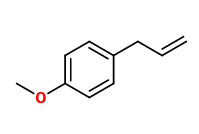
Photo credits: ScenTree SAS
Estragole
4-allyl anisole ; Para-allyl anisole ; Para-allyl methoxybenzene ; 4-allyl methoxybenzene ; 1-allyl-4-methoxybenzol ; 4-allylphenyl methyl ether ; Isoanethole ; Méthyl chavicol ; Chavicol methyl ether ; Esdragol ; 1-methoxy-4-(2-propen-1-yl)-benzene ; Para-methoxyallyl benzene

Photo credits: ScenTree SAS
Do you sell any of the raw materials? Would you like to let our users know?
Send an email to fournisseurs@scentree.coto learn about our advertising opportunities.
Do you sell any of the raw materials? Would you like to let our users know?
Send an email to fournisseurs@scentree.coto learn about our advertising opportunities.
General Presentation
-
CAS N° : 140-67-0
-
EINECS number : 205-427-8
-
FEMA number : 2411
-
Density : 0,96
-
Optical rotation : Donnée indisponible
-
Allergens : This ingredient does not contain any allergen.
-
Refractive Index @20°C : Donnée indisponible
-
Volatility : Head
-
Price Range : €
-
Appearance : Colorless liquid
-
FLAVIS number : Donnée indisponible.
-
JECFA number : 1789
Information on synthetic ingredients
-
Acid Value : Donnée indisponible
-
Boiling Point : 216°C
-
Detection Threshold : Donnée indisponible.
-
Molecular formula : C10H12O
-
Log P : Donnée indisponible.
-
Molecular Weight : 148,22 g/mol
-
Fusion Point : Donnée indisponible.
-
Flash Point : 82°C
-
Vapor pressure : Donnée indisponible
Uses
Other comments :
Estragole is also called Methyl-Chavicol. Its name is due to its presence in Tarragon EO.
Stability :
Aromatic compounds are chromophorous. This means that they may colour through time or in an alkaline medium.
Uses in perfumery :
Estragole brings an anisic and green facet in a composition. It is overall used in masculine fragrances in low quantity to bring a sweet effect, while Anethole is even sweeter. Estragole is also used due to its low cost.
Year of discovery :
Data not available.
Isomerism :
Estragole is a positional isomer of Anethole. The carbon double bond of these molecules is not at the same place. They have a very similar smell. Anethole remains anyway a very neutral anisic note, and has a less green and aromatic character.
Synthesis precursor :
Estragole is not used for the synthesis of another compound use din perfumery.
Natural availability :
Estragole is found in nature in some essential oils : Tarragon EO, Basil (Estragol chemotype) EO and Turpentine EO for example. It can be extracted from them by distillation.
Synthesis route :
In most cases, Estragole is not synthesized. It is extracted from essential oils as Tuprentine EO, having a very low cost. Then, a distillation of this oil ables to recover Estragole. Another way to get it strating with this oil is to treat it in petroleum ether, with an aqueous solution of mercury acetate, followed by heating the aqueous phase with zinc and sodium hydroxyde. This is a more costly way of obtaining Estragole, but with a better yield.
Regulations & IFRA
-
IFRA 51th : This ingredient is restricted by IFRA
-
Restriction type : RESTRICTION
-
Cause of restriction : DERMAL SENSITIZATION AND SYSTEMIC TOXICITY
-
Amendment : 49
- Quantitative limit on the use :
-
Cat.1 Cat.2 Cat.3 Cat.4 Cat.5A B C DCat.6 0,012 % 0,023 % 0,012 % 0,42 % 0,075 % 0,0062 % 0,012 % 0,0021 %0,031 % Cat.5A B C DCat.6 0,075 % 0,0062 % 0,012 % 0,0021 %0,031 % Cat.7A BCat.8 Cat.9 Cat.10A BCat.11A BCat.12 0,012 % 0,012 %0,0021 % 0,05 % 0,05 % 0,05 %0,0021 % 0,0021 %1,5 % Cat.10A BCat.11A BCat.12 0,05 % 0,05 %0,0021 % 0,0021 %1,5 %

